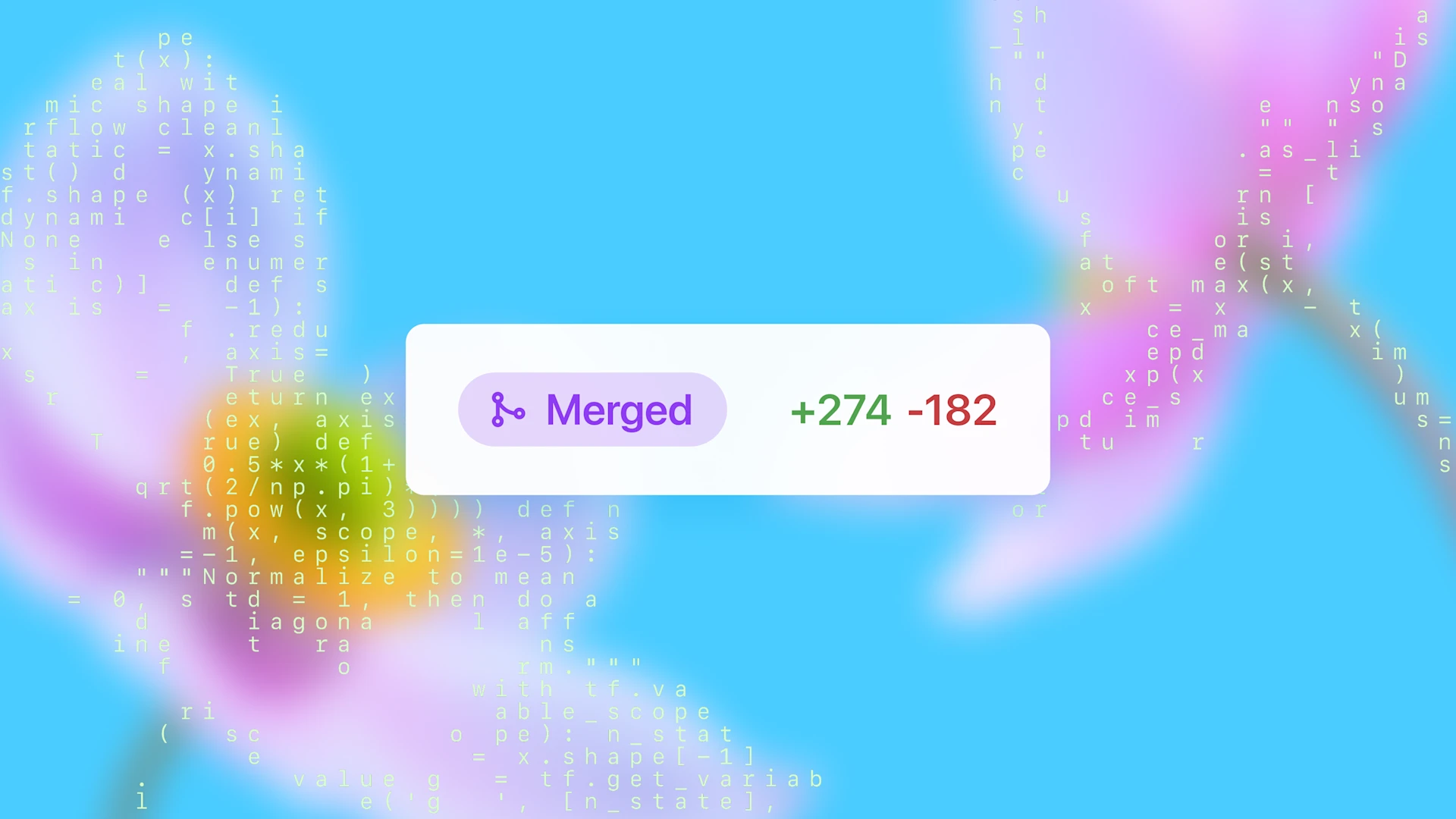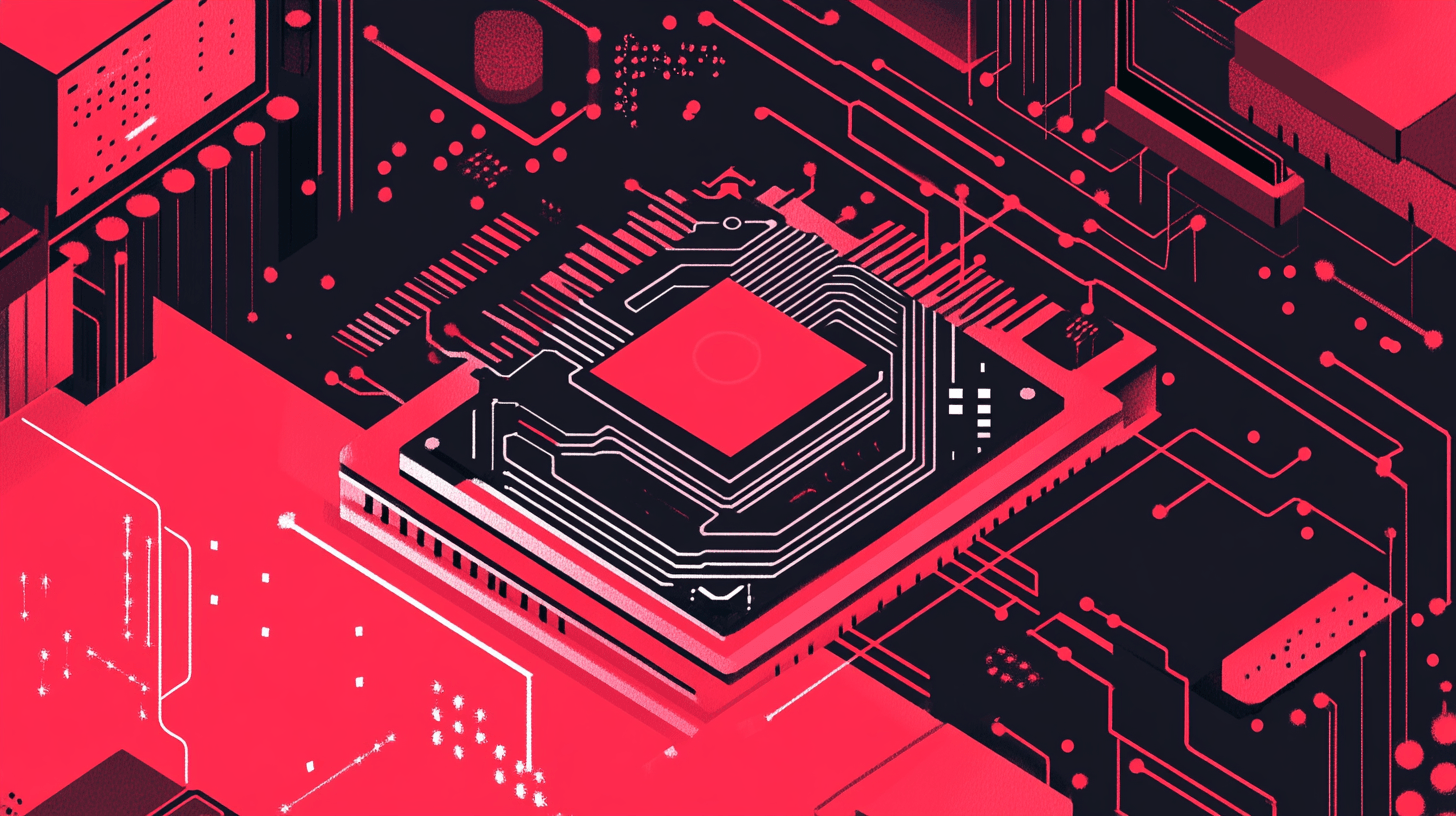ARTICLE AD BOX
Fresh usage reports from OpenAI and Anthropic paint a detailed picture of what’s happening inside the most popular AI assistants. The findings show clear differences: ChatGPT is mostly about writing and decision support, while Claude is heavily used for coding and enterprise automation.
OpenAI’s report "How People Use ChatGPT" tracks activity only from consumer plans (Free, Plus, Pro). It automatically classifies every in-app message as work- or non-work-related. Business, Enterprise, Education, and API traffic are excluded. Messages from logged-out users, deleted or banned accounts, those under 18, and users who opted out of training were also removed.
The work vs. non-work split is based entirely on message content, not subscription tiers. OpenAI notes that its weekly active user (WAU) count could slightly overstate usage since individuals may use multiple accounts or devices.
Anthropic’s latest Economic Index looks at two distinct sources: one million Claude.ai conversations (Free and Pro) collected between August 4–11, 2025, and a separate sample of one million first-party API transcripts from August 2025, representing roughly half of all API traffic.
Ad
THE DECODER Newsletter
The most important AI news straight to your inbox.
✓ Weekly
✓ Free
✓ Cancel at any time
ChatGPT use is exploding — but mostly for non-work
OpenAI reports strong growth across all consumer cohorts. By the end of July 2025, more than 700 million people were using ChatGPT weekly — about 10 percent of the global adult population. Together, they sent around 18 billion messages a week, or 2.5 billion a day, equal to 29,000 per second.
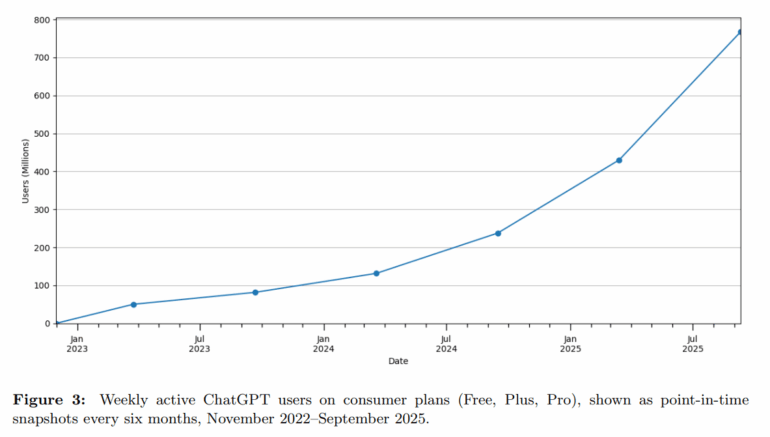 Image: OpenAI
Image: OpenAIOne striking result: personal use is outpacing work use. In June 2024, 53 percent of messages were non-work; by June 2025, that jumped to 73 percent. Daily message volume grew from 451 million to 2.6 billion over the same period, with non-work conversations growing faster due to changes in existing users’ habits.
Writing, information search, and practical help dominate
Across all contexts, three categories account for most ChatGPT activity: practical help, information search, and writing. While requests for practical help remain steady, writing has declined and information-seeking has increased. Technical support is trending down, while image generation sparked growth in multimedia queries. Educational use represents another sizable chunk. Overall, coding is rare compared to other platforms.
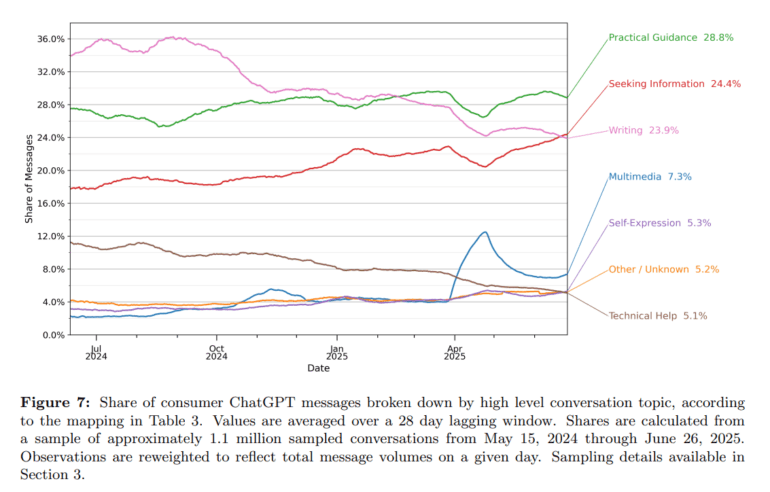
For work-related use, writing comes first, followed by practical help and technical support. Most writing requests are revisions or translations of existing text, not fresh creations.
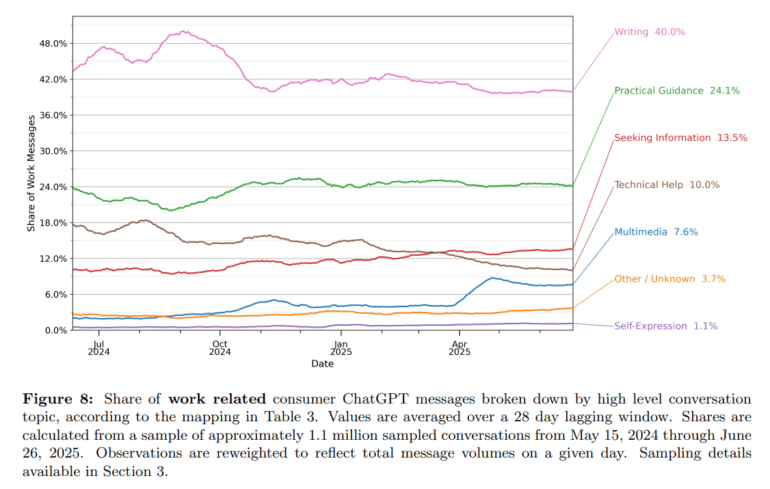 Image: OpenAI
Image: OpenAIDecision support drives ChatGPT use
OpenAI breaks down intentions into three groups: “Asking” (seeking information or advice), “Doing” (producing output), and “Expressing.” Work conversations lean heavily toward “Doing,” especially writing, but over time the balance has shifted toward “Asking.” Users are turning to ChatGPT more for advice and information than outputs.
Recommendation
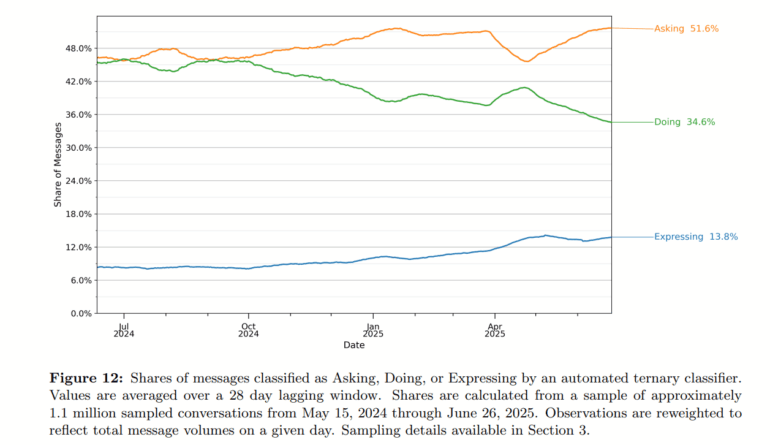 Image: OpenAI
Image: OpenAIOverall, the system is being used less like a writer and more like a thinking partner. Across both work and non-work, the most common actions are retrieving, interpreting, and documenting information. That pattern holds across professions, where knowledge work and decision support dominate.
User ratings reinforce the split: “Asking” interactions are rated most helpful, while multimedia and technical queries get lower marks. OpenAI validated the classifications against public chat logs and found accuracy to be high in core categories like work vs. non-work and user intent.
Demographics are shifting — education and job type matter
ChatGPT’s earliest user base had a strong male skew, but that has mostly leveled off. Younger adults use ChatGPT most often, though the percentage of work-related conversations rises with age (except for seniors). Recent growth has been strongest in low- and middle-income countries.
Education and profession strongly influence work use. Those with a college degree, or in well-paid professions, are far more likely to use ChatGPT at work. For knowledge workers, information search and advice dominate. For managers and business professionals, writing is the top use. For IT roles, technical help leads.
Claude.ai: Education, science, and coding
Anthropic’s index shows Claude is seeing more use in education and scientific contexts, while coding remains a significant share. A notable trend: people are increasingly delegating entire tasks to Claude (“directive” usage), shifting coding toward building new programs rather than bug fixing.
New features like web search, research mode, and tools for analyzing multimedia documents have reshaped patterns of use.
Adoption is highest in wealthy countries
Anthropic also looked at geography through a new per-capita usage index. Per-active-worker adoption is especially high in small, wealthy, tech-forward countries like Israel, Singapore, and Australia. Many emerging economies, by contrast, have very low adoption rates. Globally, there’s a clear correlation between income and AI uptake.
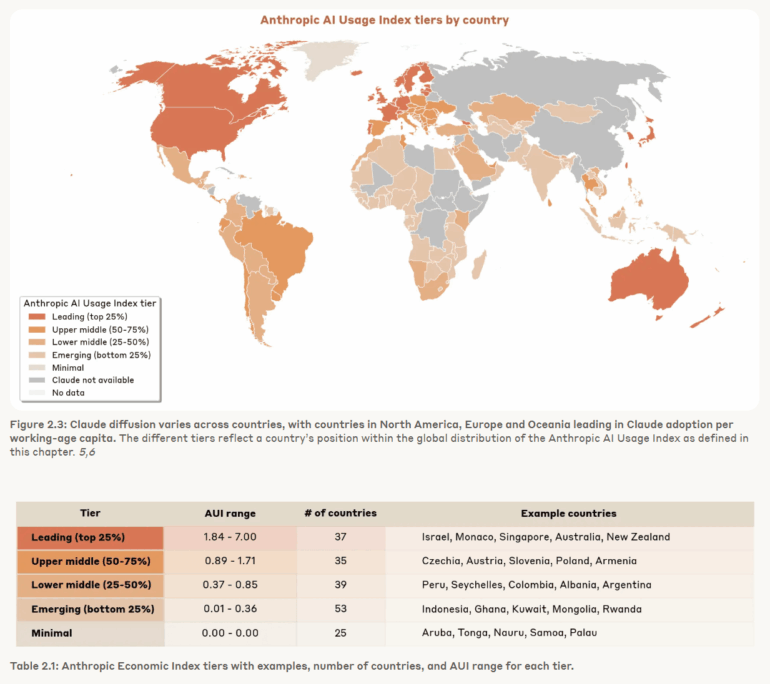 Image: Anthropic
Image: AnthropicInside the US, usage differs sharply. Washington, DC and Utah stand out for higher-than-average Claude activity. Thematic diversity grows with adoption: advanced markets show use across education, science, administration, and the arts, whereas low-adoption countries see Claude used mainly for coding.
Another split: in advanced markets, Claude is more often used as a collaborator or learning assistant. In less developed AI markets, it’s more often tasked with full automation.
Enterprise Claude use: automation first, price secondary
For the first time, Anthropic’s report also tracks how businesses use Claude via API. Common uses include software development (fixing bugs, building business apps, solving technical problems), improving or testing AI systems, generating marketing copy, and processing applicant resumes.
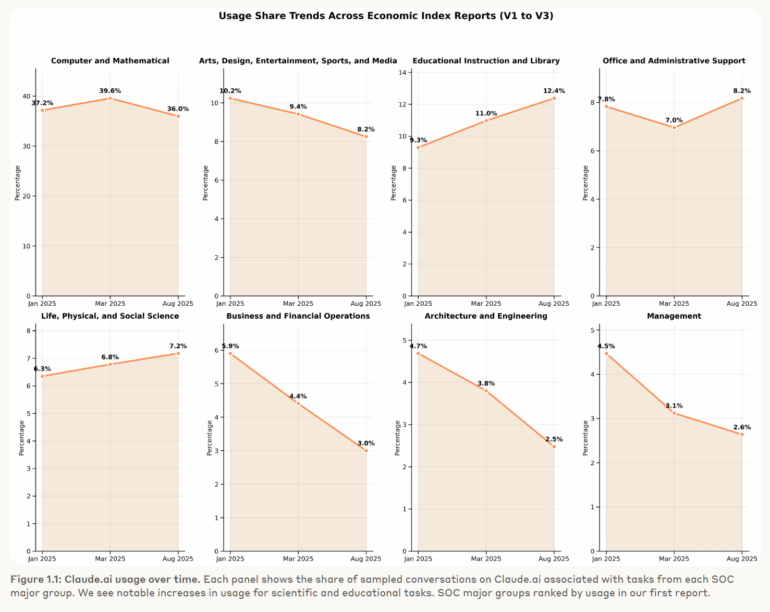
The dominant pattern is automation. Most companies let Claude handle complete tasks with little human oversight. Very few use Claude for collaborative workflows.
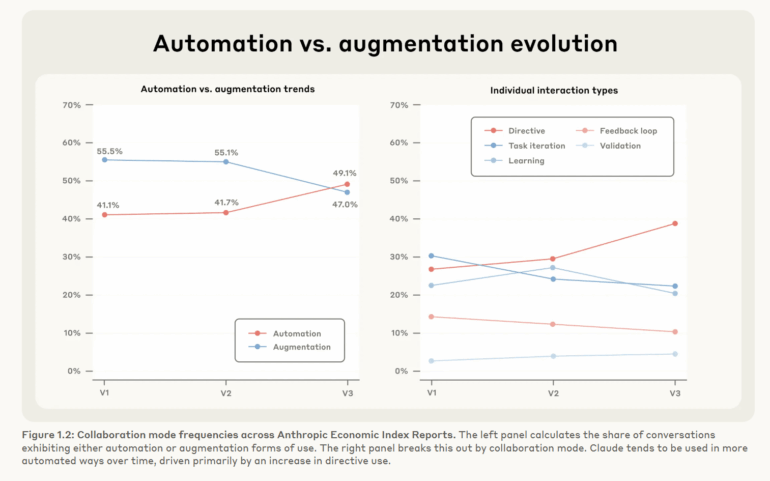 Image: Anthropic
Image: AnthropicThe main challenge: many firms don’t supply Claude with all the data and documents it needs for complex work. Without proper context, automation quickly hits limits. Price, however, is less of a factor. Even costly tasks are often automated if they’re technically simple and deliver measurable value. Anthropic suggests adoption hinges more on clarity of business value and smooth integration into workflows than on price alone.
Two distinct but complementary pictures of AI use
Taken together, the reports suggest two different but complementary roles for generative AI. ChatGPT shows broad consumer adoption as a tool for writing, information search, and decision support — with “Asking” on the rise. Claude shows more directive use in advanced consumer markets and heavy automation in enterprise contexts, especially API-driven coding tasks.
The gap, however, reflects coverage differences: OpenAI didn’t analyze business accounts or API data, while Anthropic’s report included both.
Both companies note a larger concern: adoption is uneven. Advanced, wealthy regions are seeing the most diverse use cases, while emerging markets rely more heavily on automation and coding.

 4 hours ago
1
4 hours ago
1

